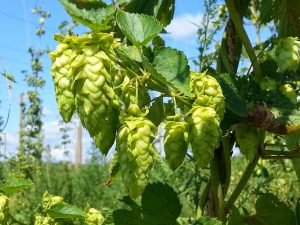Hops
 Hops are the green, cone-shaped flowers of the female hop plant, also known by its scientific name Humulus Lupulus. Hops are full of alpha acids, which are the main bittering agent brewers use to balance the sweetness in the beer imparted by grain during the brewing process. Hops are also a concentrated source of the essential oils that lend many beers their signature, intoxicating flavours and aromas. And before modern refrigeration, hops served as an important beer preservative.
Hops are the green, cone-shaped flowers of the female hop plant, also known by its scientific name Humulus Lupulus. Hops are full of alpha acids, which are the main bittering agent brewers use to balance the sweetness in the beer imparted by grain during the brewing process. Hops are also a concentrated source of the essential oils that lend many beers their signature, intoxicating flavours and aromas. And before modern refrigeration, hops served as an important beer preservative.
How Are Hops Used In Beer?
Brewers use hops in beer to varying degrees. In some styles, like IPA, hops take centre stage. In other styles, like stouts, hops typically play a less obvious role; they add backbone and depth, but the beer’s flavour and aroma is mostly defined by the grain bill.
Coaxing particular characteristics out of hops takes skill and experience. Brewers manipulate which varieties of hops they use and for how long they’re boiled to achieve particular effects.
Types of Hops
Hop strains differ in terms of their alpha acid and essential oil levels. Hops with high amounts of alpha acids are especially useful for adding sharp, angular bitterness to a finished beer. Hops with loads of essential oils contribute the most in terms of flavour and aroma. Some strains have sufficient levels of both to be appropriate for all three applications.
In general, hop strains are categorized by their geography of origin. The three most prominent categories are Noble hops, which come from Germany and the Czech Republic; American hops from the United States; and English hops from England. Within each category, there are many hop strains to choose from.
Noble Hops
Of the three categories, Noble hops, which includes strains like Saaz and Tettnanger, are considered the most classic. They are what lend traditional German and Czech pilsners and lagers their characteristic flavour profiles. Noble hops tend to be particularly rich in the high-aroma essential oil humulene and have low alpha acid levels.
American Hops
American hops, such as Cascade and Centennial, tend to be bold, bright, and highly aromatic. In general, they have higher amounts of the essential oil myrcene, which gives them their characteristic citrus and pine notes.
English Hops
In contrast, English hops (Fuggle is an example) have lower levels of myrcene. This allows the more subtle aromas of other essential oils to shine through. The profiles of English hops, therefore, tend to be more delicate and mild. Notes of earth, molasses, herbs, spice, and wood are common. English hops constitute only a small percentage of hops grown worldwide but are imperative to traditional British ales.
Timing of Hop Additions
Hops may be added at different stages during the boil, depending on the desired effect:
- ‘Bittering hops’ are added at the beginning of the boil, and are usually characterized by high alpha acid contents and lower aroma. Typical bittering hop varieties are Chinook , Magnum, Galena, Warrior, and also lower alpha acid Noble hop varieties such as Saaz.
- ‘Flavour hops’ are added midway through the boil. Typical flavour hop varieties are Citra, Mosaic, Amarillo, and Simcoe.
- ‘Aroma hops’ (or ‘finishing hops’) are added at the very end of the boil. Typical aroma hop varieties are Citra, Centennial, Cascade, and Galaxy.
- ‘Dry hops’ are added to the fermenter or keg. Typical dry hop varieties are Citra, Simcoe, Centennial, Willamette, Idaho 7, Galaxy, Palisade, and Warrior.
